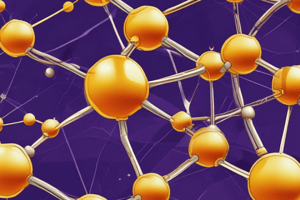Podcast
Questions and Answers
What is the primary reason for the high melting and boiling points of metals?
What is the primary reason for the high melting and boiling points of metals?
What is the primary reason for the excellent conductivity of metals?
What is the primary reason for the excellent conductivity of metals?
What is the primary reason for the malleability of metals?
What is the primary reason for the malleability of metals?
What is the primary reason for the increased hardness of alloys compared to pure metals?
What is the primary reason for the increased hardness of alloys compared to pure metals?
What is the term used to describe the delocalized electrons in a metal?
What is the term used to describe the delocalized electrons in a metal?
What is the result of each metal atom losing its outer electron?
What is the result of each metal atom losing its outer electron?
Flashcards are hidden until you start studying
Study Notes
Metallic Bonding
- Metals consist of a giant structure of atoms arranged in regular layers.
- In metals, the outer electrons are delocalized, meaning they are not attached to any individual atom and are free to move through the whole structure.
- These delocalized electrons are often referred to as a "sea of delocalized electrons".
- Each metal atom loses its outer electron, resulting in positive metal ions.
- The strong electrostatic attraction between the sea of delocalized negative electrons and the positive metal ions is called a metallic bond.
Properties of Metals
- Metals have high melting and boiling points due to the strong metallic bonds that need to be broken.
- Metals are excellent conductors of heat and electricity due to the delocalized electrons that can move and carry thermal energy and electric current.
- Metals can be bent and shaped because the layers of atoms can slide over each other.
Alloys
- An alloy is a mixture of metals.
- In an alloy, the different sizes of atoms distort the layers, making it more difficult for the layers to slide over each other.
- This makes alloys harder than pure metals.
- Examples of metals that can be made harder by forming an alloy include copper, gold, iron, and aluminum.
Metallic Bonding
- Metals have a giant structure of atoms arranged in regular layers, with outer electrons delocalized, meaning they're not attached to individual atoms and can move freely.
- Delocalized electrons form a "sea of electrons" that allows them to move through the entire structure.
- Metal atoms lose their outer electrons, resulting in positive metal ions.
- The strong electrostatic attraction between the delocalized negative electrons and positive metal ions is called a metallic bond.
Properties of Metals
- Metals have high melting and boiling points due to strong metallic bonds that need to be broken.
- Metals are excellent conductors of heat and electricity because delocalized electrons can move and carry thermal energy and electric current.
- Metals can be bent and shaped because the layers of atoms can slide over each other.
Alloys
- An alloy is a mixture of metals, where different-sized atoms distort the layers, making it harder for the layers to slide over each other.
- Alloys are harder than pure metals due to the distorted layers.
- Examples of metals that can be made harder by forming an alloy include copper, gold, iron, and aluminum.
Studying That Suits You
Use AI to generate personalized quizzes and flashcards to suit your learning preferences.




